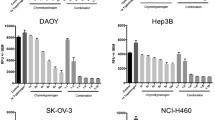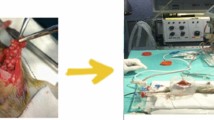Abstract
Background
The balance between proteolysis and protease inhibition in the formation and breakdown processes of the extracellular matrix plays a major role in tumor cell invasion. An understanding of this relationship gave rise to the therapeutic concept of lowering tumor cell invasion by inhibiting protease activity. Phosphoramidon is an unspecific proteinase inhibitor. This experimental study investigated the effect of intraperitoneal phosphoramidon administration on tumor growth in a laparoscopic rat model.
Methods
In the first phase of the study, we investigated the influence of phosphoramidon on tumor cell invasion in a collagen matrix gel chamber in vitro. In a second experiment, a suspension of colon carcinoma cells (CC531) was introduced into the peritoneal cavity of male WAG rats. Prior to laparoscopy (at 6 mmHg for 20 min), the animals were randomized to two groups. At the start of laparoscopy, the test substance was applied intraperitoneally (group 1: controls, 1 ml 0.9% NaCl; group 2: 250 mg phosphoramidon in 1 ml 0.9% NaCl). Three weeks after the injection of tumor cells, the animals were autopsied and the tumor mass determined.
Results
In comparison with the control group (tumor weight 7.42±1.01 g), intraperitoneal tumor growth in the experimental group was significantly (p<0.001) reduced by the application of phosphoramidon (tumor weight, 3.22±1.06 g). Phosphoramidon also significantly (p<0.05) reduced tumor cell invasion through the matrix gel.
Conclusion
The proteinase inhibitor phosphoramidon reduced tumor cell invasion in vitro and tumor cell growth in vivo in this laparoscopic rat model.
Similar content being viewed by others
References
Albini A, Iwamoto Y, Kleinman HK, Martin GR, Aaronson SA, Kozlowski JM, McEwan RN (1987) A rapid in vitro assay for quantitating the invasive potential of tumor cells. Cancer Res 47: 3239–3245
Anand-Apte B, Bao L, Smith R, Iwata K, Olsen BR, Zetter B, Apte SS (1996) A review of tissue inhibitor of metalloproteinases-3 (TIMP-3) and experimental analysis of its effect on primary tumor growth. Biochem Cell Biol 74: 853–862
Bouvy D, Giuffrida MC, Tseng LN, Steyerberg EW, Marquet RL, Jeekel H, Bonjer HJ (1998) Effects of carbon dioxide pneumoperitoneum, air pneumoperitoneum, and gasless laparoscopy on body weight and tumor growth. Arch Surg 133: 652–656
Bouvy ND, Marquet RL, Jeekel H, Bonjer HJ (1996) Impact of gas(less) laparoscopy and laparotomy on peritoneal tumor growth and abdominal wall metastases [see Comments]. Ann Surg 224: 694–700 DOI: 10.1097/00000658-199612000-00005
Declerck YA, Imren S, Montgomery AM, Mueller BM, Reisfeld RA, Laug WE (1997) Proteases and protease inhibitors in tumor progression. Adv Exp Med Biol 425: 89–97
Eccles SA, Box GM, Court WJ, Bone EA, Thomas W, Brown PD (1996) Control of lymphatic and hematogenous metastasis of a rat mammary carcinoma by the matrix metalloproteinase inhibitor batimastat (BB-94). Cancer Res 56: 2815–2822
Evans JD, Ghaneh P, Kawesha A, Neoptolemos JP (1997) Role of matrix metalloproteinases and their inhibitors in pancreatic cancer. Digestion 58: 520–528
Ghadimi BM, Schlag PM (1998) [Tumor metastasis: molecular principles and therapeutic options]. Chirurg 69: 1315–1322 DOI: 10.1007/s001040050576
Hubens G, Pauwels M, Hubens A, Vermeulen P, Van Marck E, Eyskens E (1996) The influence of a pneumoperitoneum on the peritoneal implantation of free intraperitoneal colon cancer cells. Surg Endosc 10: 809–812 DOI: 10.1007/s004649900166
Imren S, Kohn DB, Shimada H, Blavier L, Declerck YA (1996) Overexpression of tissue inhibitor of metalloproteinases-2 retroviralmediated gene transfer in vivo inhibits tumor growth and invasion. Cancer Res 56: 2891–2895
Jacobi CA, Ordemann J, Bohm B, Zieren HU, Sabat R, Muller JM (1997) Inhibition of peritoneal tumor cell growth and implantation in laparoscopic surgery in a rat model. Am J Surg 174: 359–363 DOI: 10.1016/S0002-9610(97)00099-8
Jacquet P, Sugarbaker PH (1996) Wound recurrence after laparoscopic colectomy for cancer: new rationale for intraoperative intraperitoneal chemotherapy [Editorial]. Surg Endosc 10: 295–296 DOI: 10.1007/s004649910044
Kolkhorst V, Sturzebecher J, Wiederanders B (1998) Inhibition of tumour cell invasion by protease inhibitors: correlation with the protease profile. J Cancer Res Clin Oncol 124: 598–606 DOI: 10.1007/ s004320050221
Nagase H (1997) Activation mechanisms of matrix metalloproteinases. Biol Chem 378: 151–160
Neuhaus SJ, Ellis T, Rofe AM, Pike GK, Jamieson GG, Watson DI (1998) Tumor implantation following laparoscopy using different insufflation gases [see Comments]. Surg Endosc 12: 1300–1302 DOI: 10.1007/s004649900845
Neuhaus SJ, Texler M, Hewett PJ, Watson DI (1998) Port-site metastases following laparoscopic surgery. Br J Surg 85: 735–741
Neuhaus SJ, Watson DI, Ellis T, Dodd T, Rofe AM, Jamieson GG (1998) Efficacy of cytotoxic agents for the prevention of laparoscopic port-site metastases. Arch Surg 133: 762–766
Reymond MA, Schneider C, Hohenberger W, Kockerling F (1997) [Pathogenesis of puncture-site metastases after laparoscopy]. Zentralbl Chir 122: 387–394
Reymond MA, Schneider C, Kastl S, Hohenberger W, Kockerling F (1998) The pathogenesis of port-site recurrences. J Gastrointest Surg 2: 406–414
Sugarbaker PH, Cunliffe WJ, Belliveau J, de Bruijn EA, Graves T, Mullins RE, Schlag P (1989) Rationale for integrating early postoperative intraperitoneal chemotherapy into the surgical treatment of gastrointestinal cancer. Semin Oncol 16: 83–97
Targarona EM, Martinez J, Nadal A, Balague C, Cardesa A, Pascual S, Trias M (1998) Cancer dissemination during laparoscopic surgery: tubes, gas, and cells. World J Surg 22: 55–60 DOI: 10.1007/s002689900349
Watson SA, Morris TM, Parsons SL, Steele RJ, Brown PD (1996) Therapeutic effect of the matrix metalloproteinase inhibitor, batimastat, in a human colorectal cancer ascites model. Br J Cancer 74: 1354–1358
Wexner SD, Latulippe J (1998) Laparoscopic colorectal surgery and cancer Dig Surg 15: 117–123
Author information
Authors and Affiliations
Additional information
Online publication: 2 May 2001
Rights and permissions
About this article
Cite this article
Pross, M., Lippert, H., Mantke, R. et al. A proteinase inhibitor decreases tumor growth in a laparoscopic rat model. Surg Endosc 15, 882–885 (2001). https://doi.org/10.1007/s004640090029
Received:
Accepted:
Issue Date:
DOI: https://doi.org/10.1007/s004640090029




